As of the beginning of 2023, over 64.3% of the global population, 5.16 billion people, had access to the internet.
New data suggests that the number of people using the internet increased by about 100 million in the year leading up to January 2023.
This annual increase rate of almost 2% is significantly below the growth rates seen over the past decade.
Nevertheless, delays in collecting and reporting studies concerning technology acceptance regularly certainly mean that the actual growth rate is more significant than these newest figures suggest.
So, how reliant are Australians online?
This post has compiled crucial stats on the Aussies’ routines on the internet.
Let’s get down to it.
Aussie Internet Stats That Cast a Wide Net
Stats on Internet Usage in Australia
1. Over 91% Of Australians Are Online.
- Data by Statista
There are now over 23.5 million Australians online, which is an improvement from 2022’s 22.7 million. Australia’s online penetration rate rose to 89% in 2022, and the market for online consumers is anticipated to be fully saturated by 2025. The increase in internet users started to be significant in 2015.
2. Over 55% Of Aussies Cannot Live Without Going Online
- Data by Statista
Nearly 60% of Australians between 16 to 64 think they can only function normally with constant access to the internet. In addition, a majority, 52%, value reliable mobile internet connection. Therefore, it is encouraging that 50% of people living in Australia feel they have decent network cover and that 23% value access to 5G, a cutting-edge mobile network.

3. 55.41% Of Australian Internet Traffic Was Computer-Based in February 2022
- Data by Statista
As of February 2022, desktop and laptop computers accounted for over half of all Internet traffic in Australia. Afterwards, 39.88% of all internet traffic in Australia comes through mobile phones, 4.68 % from tablets, and 0.03% from other devices.
4. In July 2022, Australia Had 161.61 Mbps Mobile Download Speeds
- Data by Statista
The load time of mobile internet in Australia in July 2022 was significantly higher than that of broadband connections, which was at 87.2 Mbps at the time. Mobile upload speeds averaged 17.96 Mbps, while the upload speed in fixed broadband was 29.44 Mbps.
5. Aussies Downloaded Over 10.7 Million Terabytes in the Final Quarter of 2022
- Data by Internet activity records
There was a 13% rise in total data downloads in December 2022 compared to the nine million TB received in the same month of 2020. Most Australians (86%) rely on NBN services for internet access. To this, mobile services provide 9%, while the non-NBN effect contributes 5% of all downloads.
6. NBN Users Download Over 409GB Each Month.
- Online Report
Thanks to the limitless data downloads offered by NBN subscriptions, Australia’s Consumer Commission discovered that Internet usage was rising in their most recent report. In June of 2022-2022, the average Australian NBN subscriber downloaded 361.5 GB of data.
In the final quarter of 2022, users of stationary internet providers other than those provided by the National Broadband Network (NBN) downloaded 346 gigabytes of data on average. The average monthly download for HFC users is 383 GB; for fibre subscribers, it’s 420 GB; for DSL consumers, it’s 302 GB; and for satellite clients, it’s a meagre 156 GB.
7. In 2022, Over 79% Of Australian Adults Used Smart Devices, Internet-Connected
- Data by Statista
The majority of Australians (nearly 80%) will have smart devices by 2022, according to estimates from surveys of internet users. In 2022, Samsung was the most popular brand for innovative household management solutions, trailed by Google, Nest, and Philips.
Over 79% of Aussies use smart gadgets connected to the internet, primarily for entertainment. About 21% use smart lighting, another 21% link via a smart wearable product, and 26% utilise home technology like smart microwaves and robot cleaners. On the other hand, 18% indicated they didn’t have any internet-connected devices.
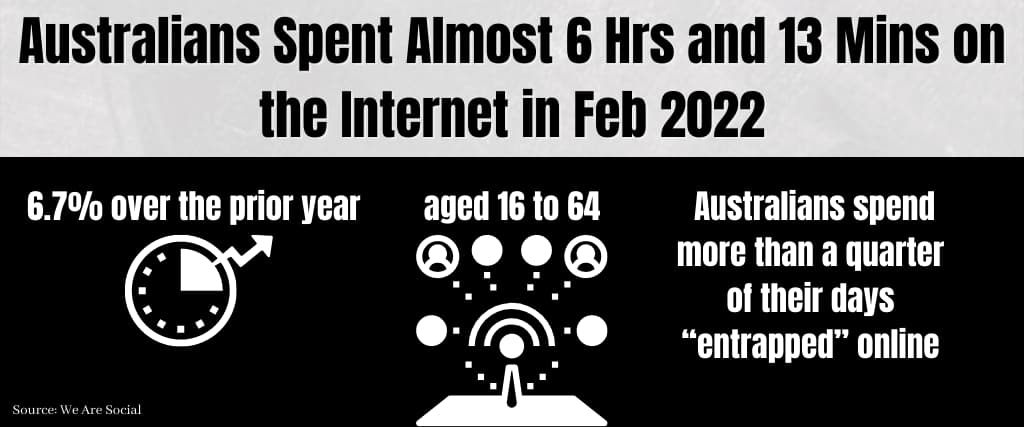
8. Australians Spent Almost 6 Hrs and 13 Mins on the Internet in Feb 2022
- Data by We Are Social
Daily internet use among Australians aged 16 to 64 was consistent with usage in 2022. According to these numbers, Australians spend more than a quarter of their days “entrapped” online. The average Australian now spends 3 hours + 44 minutes per day in front of the tube, up 6.7% over the prior year.
9. Australian Millennials Utilize the Internet Most
- Data by Statista
According to recent studies, the most significant percentage of internet users are between 25 and 34. Additionally, 3.76 million respondents within this age range reported using the internet.
The next largest demographic to use the internet is individuals aged 35 to 44—those between the ages of 45 and 54 (3.26 million and over 3.15 million, respectively).
Older Australians prefer to avoid using the internet, which is to be anticipated. People between the ages of 55 and 64 make up 2.68 million internet users, while 2.9 million people 65 and up also have access to the web.
The average pension age throughout Australia has been rising slowly through the years, and more folks rely on the internet for their livelihoods. Therefore, the proportion of senior citizens who use the internet will grow in the coming years.
However, just 2.33 million people in the 18–24 age range were included in the poll, making them the least likely to use the internet.
10. In June 2022, 35% Of Aussies Used at Least Five Gadgets to Access the Internet
- Data by ACMA
Figures from 2020 show that 46% of homes have five or more internet-connected devices. By June 2022, the numbers had dropped to 41%. In June 2022, 22% of families used an average of four gadgets to access the internet, 21% utilised three, 15% utilised two, and 7% only used one device.
Data From Search Engine Usage
11. In 2022, 98% Of Australians Used at Least One Search Engine
- Data by Statista
Search engines are ubiquitous in Australia, so collecting data on their use is quite simple. Comparatively, 61% of Australians reported shopping online within the preceding four weeks. Additionally, 61% reported using social media.
Almost 60% of adults had viewed videos on streaming services like YouTube, while only 40% had visited the sites of individual businesses. Moreover, 38% of participants received the news via specialised websites and apps, 18% read blogs, and about 16% received newsletters.
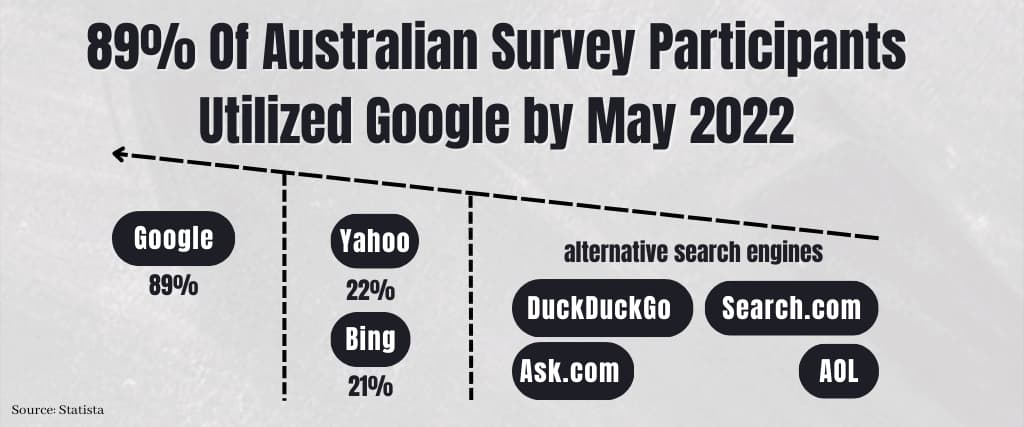
12. 89% Of Australian Survey Participants Utilized Google by May 2022
- Data by Statista
Findings from a 2022 study of SEO specialists show that Google is the most popular search engine among Australians. Bing and Yahoo come in second and third, with a market share of 22% and 21%, respectively. Australians also use these alternative search engines:
- DuckDuckGo
- Ask.com
- Search.com
- AOL
Moreover, throughout April 2022, Google accounted for 90.23% of all desktop web traffic in Australia, which is to be expected given its dominant market position. The availability of refurbished models has also contributed to their increased availability.
13. Google Chrome Dominated Australia’s Internet Traffic Throughout Sep 2022
- Data by StatCounter
A study on the continent-wide user base of browsers in September 2022 revealed that Chrome accounted for 51.5% of total internet traffic. This percentage is down from August’s 53.8% when Chrome traffic was the most used browser.
There are several popular web browsers, but only a tiny percentage of the overall market share. Chrome’s 66.7% market share was far ahead of Safari’s 33.3%, with Microsoft Edge in the third at 6.7%. Mozilla and Internet Explorer each enjoyed less than 1%.
Statistics on Australian Internet Service Providers
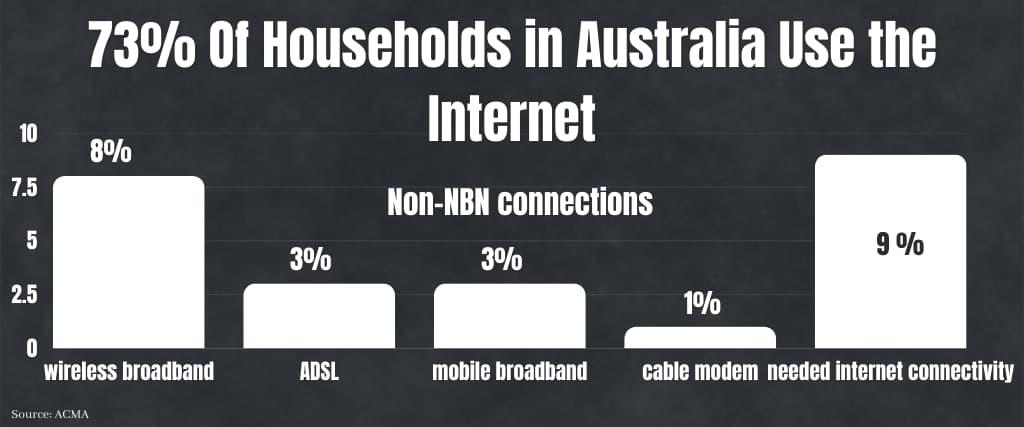
14. 73% Of Households in Australia Use the Internet
- ACMA
Non-NBN connections included over 8% using wireless broadband, ADSL accounted for 3%, 3% using mobile broadband, and just 1% using a cable modem at home. By June 2022, just 9% of homes in Australia needed internet connectivity.
15. Telstra Provided 29% Of Australian Home Internet Access in 2022–2022
- Data by Statista
Nearly 30% of Aussies with home internet connectivity by 2022 chose Telstra as their ISP. Optus comes in at a distant second with 14%. Market share was split as follows: Aussie Broadband and TPG at 9%, Dodo and iiNet at 7%, Belong at 6%, and Vodafone and Foxtel at 4%.
While iPrimus and SpinTel accounted for 2% and 1% (respectively) of Australians with internet access, the remaining ISPs combined for only 8% of the market.
16. Over 88% of Aussie Broadband Subscribers Are Happy With Their Internet Providers
- Data by Statista
Aussie Broadband won the 2022 Internet Service Provider of the Month Award with the highest customer satisfaction ratings.
The highest customer satisfaction rate was 80% for IPrimus, followed by 79% for Belong, 78% for Vodafone, 77% for TPG, and 76% for Extel. Following iiNet (76% happy users) were Optus (75%) and Telstra (74%).
If you’re unhappy with Telstra, you should check our instructions for terminating your service.
17. In 2022, Australian Internet Costs Averaged $71 Monthly
- Data by Canstar Blue
Families in Australia pay $852 per year for their broadband plans. Western Australia and Tasmania had the most expensive online shopping costs in Australia, at $73 per month. On the other hand, Internet users in Victoria and Queensland pay $72 per year, which is only $2 more than the national average.
Meanwhile, South Australians pay the least per month for an NBN package, at $68.
Statistical Analysis of Mobile Internet
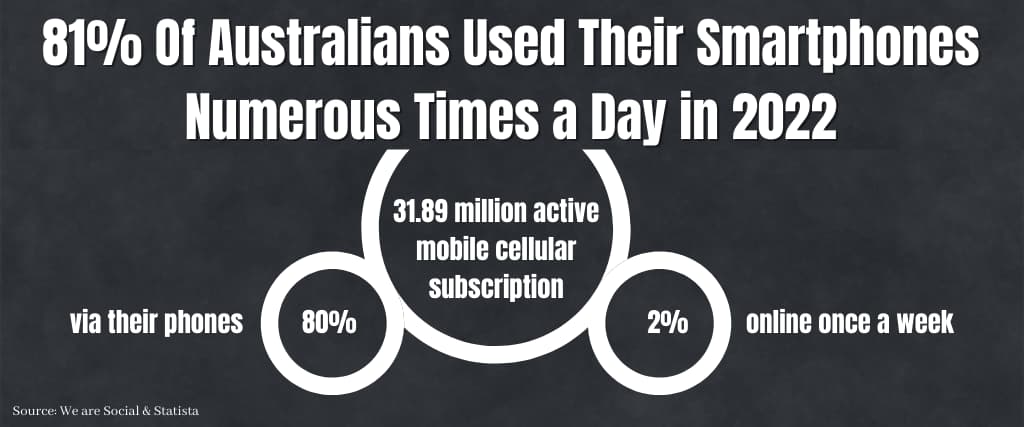
18. 81% Of Australians Used Their Smartphones Numerous Times a Day in 2022
- Data by We are Social & Statista
More than 80% of Australian individuals connect to the internet daily via their phones, compared to 2% who only go online once a week. This indicates the prevalence of smartphones in Australia. Australia now has 31.89 million active mobile cellular subscriptions in total.
19. 23.21 Million Australians Will Use Mobile Broadband by 2025
- Data by Statista
According to data and information about Australians’ mobile internet use in 2022, there were 34 million mobile internet subscriptions and 21.57 million active internet subscribers. Throughout the next quadrennial, both figures increased steadily, eventually reaching 35.76 million.
20. Just Only 16% Of Aussies Deplete Their Mobile Data
- Data by Statista
According to a 2022 survey, over 84% of Aussies only partially use their cellular data limits. Although 54% claim to have leftover Megabytes by the month’s end, 30% say they use nearly all of their monthly limit. Furthermore, 46% have restricted mobile data packages, and 32% have unrestricted cellular internet.
Statistics for Online Activities
21. Australians Spent Most of Their Time Online in 2022 Emailing
- Data by Statista
Around 98% of Australian adults in a 2022 survey said checking email was their most common online activity. In addition, 96% were web surfers, 92% were online bankers, 90% were video viewers, 85% were news readers, and 85% were online shoppers. About 37% of people made some sort of online post or interaction, and 64% listened to the audio.
It’s not a surprise that, in the wake of the COVID outbreak, teleconferencing or calling (64%), home-based work (45%), telemedicine consulting (41%), online shopping (37%), and distance learning (30%) were the most popular online applications among Australians.
While 21% bought lotto tickets and 11% gambled online, only 16% sought advice from lawyers and accountants.
22. TikTok Was Australians’ Favorite Website
- Data by We are Social
TikTok is Australia’s most widely used social media platform, accounting for 23.4 hours per month of website use in Feb 2022. Facebook’s monthly usage in Australia is 17.6 hours, making it the second highest of any website. Aussies spend about 17.1 hours each month on YouTube, with over 50% visiting the site in search of guidance.
While Australians spent an average of 5.8 hours per week on WhatsApp, they spent 8.3 hours per week on Insta.
23. More Than 25% Of Australians Visit ABC News Online
- Data by Statista
In a study between Jan and Feb 2022, Australians were asked about which news websites they visited. Below are their response:
- ABC News Online — 26% of respondents
- News.com — 22%
- Nine.com.au — 16%
- 7News.com.au — 14%
- Guardian Australia Online — 12%
- Skynews.com.au — 9%
- Smh.com.au — 9%
- BBC news online — 9%
- Herald Sun — 7%
- The Age — 7%
24. Over 19.85 Million Aussies Make Online Purchases
- Data by We are Social
As of 2026, there were 1.2 million more consumers using money transfers, a 6.6% rise from 2022. Australians typically spend USD 4,036 per year on purchases sold online.
Australians are predicted to spend AUD 80.10 billion (USD 80.10 billion) annually on online payments. The deal amount climbed by USD 23 billion, or 41.3%, year over year, as of the most recent data in February 2022.
Apps and Social Media Statistics
25. By February 2022, the Total Number of SM Users in Australia Had Risen to 21.45 Million
- Data by Genroe
In early 2022, 82.7% of Australia’s population had active profiles on at least one social networking site. Compared to the prior year, these numbers show a change of 4.6%.
That is, 96.4% of Australians in the age bracket of 16-64 used at least one networking site as of December 2020, although utilisation dramatically dropped after age 64.
26. Over 54.3% Of Australians Use Social Media to Stay in Touch With Family and Friends
- Data by We are Social
Aussies use the web and social media to pass the time (368.2%), learn about current events (26%), discover new information (24.8%), shop for goods or plan activities (22.4%), check out the latest trends (20.9%), and amuse themselves in various ways (21%).
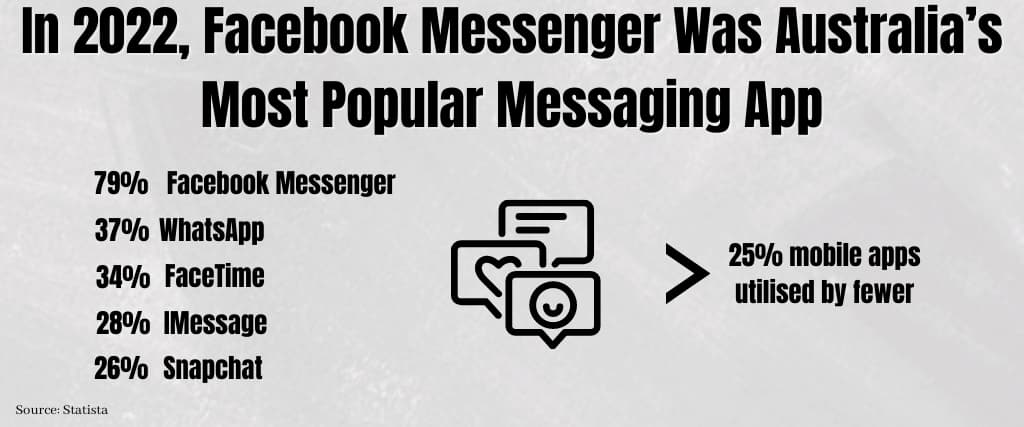
27. In 2022, Facebook Messenger Was Australia’s Most Popular Messaging App
- Data by Statista
Below are some of the most popular messaging apps for Australian smartphone users:
- Facebook Messenger — with 79%
- WhatsApp — 37%
- FaceTime — 34%
- IMessage — 28%
- Snapchat — 26%
Zoom, Discord, Microsoft Teams, Google Hangouts, Skype, and Signal are among more mobile apps utilised by fewer than 25% of Australians.
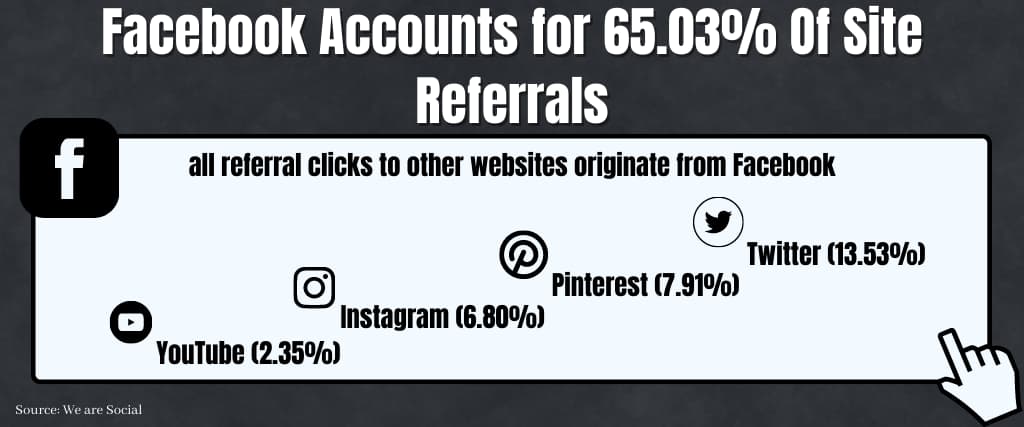
28. Facebook Accounts for 65.03% Of Site Referrals
- Data by We are Social
According to studies of social media use in Australia, over half of all referral clicks to other websites originate from Facebook. To its immediate right are Twitter (13.53%), Pinterest (7.91%), Instagram (6.80%), and YouTube (2.35%), in descending order of popularity.
Bottom Line
We are aware that Australians love to surf. However, the key lesson we can get from these internet use figures is that they are equally skilled at navigating the choppy seas of the Internet. The information above gives you confidence that as technological advances in this field continue to gain traction, they will also be able to keep up with any emerging digital trends.